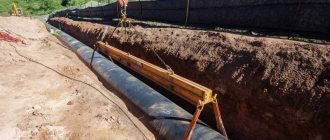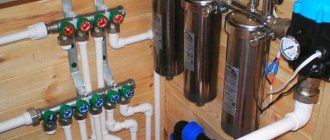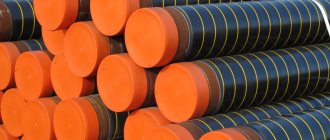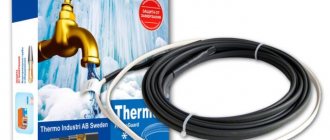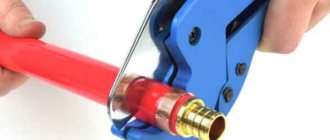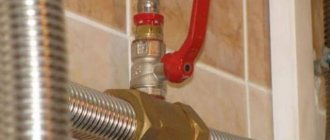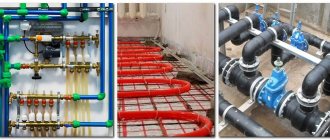Purpose
The water drainage system in most cases is installed from polyethylene pipes. Despite the strength of this material, deformation of the pipeline may occur under soil or water pressure. Such situations arise especially often when laying sewers under highways, railways, in canals or technical tunnels.
The case is an additional shell of the pipeline. The purpose of the sewer case is to protect underground pipes made of polyethylene and similar materials from negative influences from the outside. In particular, we are talking about pressure from soil, soil water and other factors that significantly reduce the service life of all elements of the sewer system.
Diameter calculation
The case for sewer pipes must have a certain diameter, which is important
take into account when laying pipes under highways and railways. When calculating, the formula most often used is:
Df = Dtr + 200 mm.
Here Da denotes the outer diameter of the containment shell, Dtr denotes the outer diameter of the working pipeline. Therefore, for a standard sewer pipe with a diameter of 110 mm, you need to use a cover with a cross-section of at least 310 mm.
Material for production
A case made of a more durable material can provide reliable protection for polyethylene sewer pipes. The type and diameter of the sewerage case are determined depending on the operating conditions and the cross-section of the internal pipeline. GOST and other regulatory documents recommend using the following:
- For pipelines of standard diameter, cases made of straight-seam welded pipe are suitable.
- Large cross-section pipelines are protected with a casing made of spiral-welded pipe.
- In places where a high load on the sewage system is expected, protection from hot-rolled seamless pipe products is used. Similar material can be used for pipelines with a diameter of up to 273 mm.
Steel pipe products require mandatory insulation, which will protect the products from the negative effects of ground moisture and aggressive substances. Asbestos-cement, sand-cement, epoxy, and polymer coatings have an anti-corrosion effect.
In some cases, the casings may be made from pipes that were previously used in a gas or water supply system. After applying an additional insulating coating, the strength of the walls increases significantly.
Private Methods
This option has the following advantages:
- Minimal excavation work.
- No destruction of road surfaces or railway tracks is required.
- Continuous traffic movement even during installation work.
For closed sewer installation, several methods are used, in each of which a cover is first installed, then a section of sewer system pipes is placed in it.
Puncture
The pipeline is laid using the puncture method if the internal diameter of the sewer case does not exceed 40 cm. A pneumatic punch with a cylindrical body is used as the main equipment. The main components of the equipment are represented by the striker and the air distribution system.
- Compressed air is supplied to the equipment body.
- Then the blow is struck. Under the influence of the impact force, the equipment moves in the ground.
- I tighten the protective casing into the resulting hole.
The main advantage of the directional puncture method is speed and minimal excavation work.
Punching
If the diameter of the sewerage case under the road is more than 80 cm, it is recommended to use the pushing method. This option involves performing the following actions:
- At one end of the steel case I fix a special knife.
- Using a hydraulic jack, the pipe is pressed into the ground.
- The knife cuts off the soil, which is then manually cleaned out of the pipe.
Auger drilling
This type of installation of a sewer casing requires the use of special equipment. Auger drilling machines help quickly lay pipelines under railroad tracks or in densely populated areas.
A special feature of using this option is the preliminary preparation of two pits. A working pit is made on one side, and a receiving well on the other. Using an auger machine, a sewer case is laid under a road up to 100 meters long. In this case, a steel, concrete or polymer cover can have a diameter from 100 to 1700 mm.
Cost of laying power cable
| Name of works | Unit | Cost of work per unit, including VAT |
| Installation of a pipeline from galvanized steel pipe 1/2″ (including the cost of materials, fittings, consumables, installation work) | p.m. | 264 rub. |
| Installation of a pipeline from galvanized steel pipe 3/4″ (including the cost of materials, fittings, consumables, installation work) | p.m. | 300 rub. |
| Installation of a 1″ steel pipeline (including the cost of materials, fittings, consumables, installation work) | p.m. | 358 rub. |
| Installation of a pipeline from galvanized steel pipe 11/4″ (including the cost of materials, fittings, consumables, installation work) | p.m. | 396 rub. |
| Installation of PP pipeline D 16-32 mm | p.m. | 177 rub. |
| Installation of shut-off and control valves, filters 1/2″ - 2″ | PC. | 236 rub. |
| Installation of pipeline passage in reinforced concrete floors up to 50mm | PC. | 1794 rub. |
| Installation of pipeline passage in reinforced concrete floors up to 150 mm | PC. | 10148 rub. |
Purpose
The water drainage system in most cases is installed from polyethylene pipes. Despite the strength of this material, deformation of the pipeline may occur under soil or water pressure. Such situations arise especially often when laying sewers under highways, railways, in canals or technical tunnels.
The case is an additional shell of the pipeline. The purpose of the sewer case is to protect underground pipes made of polyethylene and similar materials from negative influences from the outside. In particular, we are talking about pressure from soil, soil water and other factors that significantly reduce the service life of all elements of the sewer system.
Cases as protection for water pipes
We have long been spoiled by technological progress, and we can no longer imagine our existence without water, which must constantly flow from our tap.
But to ensure that this process does not stop, pipelines are needed. There are situations when a water pipe needs to be laid in a case. Previously, they pulled water on themselves. Buckets and rockers were mandatory household utensils. Civilization has made great strides forward, and now the lack of water in the tap is perceived by us almost as a universal catastrophe. Construction sites require uninterrupted water supply, which means that water pipelines must be maintained in good condition at all times, that is, repairs must be carried out in a timely manner, and leaky areas must be replaced with new ones.
Cold water is supplied to houses through utility lines running underground. To what depth they can be laid depends largely on what kind of soil predominates in a given area and how deep it freezes in winter.
The laying of water pipes is mainly carried out using the open method. To do this, dig a trench to the required depth and lay pipes in it. But trenches do not always go through flat, convenient areas. Sometimes the path to communications is blocked, for example, by roads. In such cases, a trenchless installation method is used.
To protect and eliminate external mechanical damage to the integrity of water pipes, they are laid in a case without the use of trenches. Pipes that are laid under highways require additional protection, since they experience the loads of both the soil and vehicles passing along the road.
Documents regulating the installation of external networks
The main document according to which the installation of external water supply is carried out is SNiP No. 3.05.04/85.
In addition to this, it is necessary to take into account the provisions of the following collections:
- SNiP No.III/4/80;
- SNiP No. 3.01.03/84;
- SNiP No. 3.01.01/85;
- SNiP No. 2.04.02/84.
Ready communications must be accepted for operation in accordance with SNiP No. 3.01.04/87.
According to the standards, water pipes for external water supply and sewer analogues can be:
- asbestos-cement;
- steel;
- reinforced concrete;
- cast iron;
- ceramic;
- plastic.
Plastic pipes for external water supply.
Note! Nowadays, polymer pipe products are most often used. They must have markings that allow outdoor installation. Such pipes are usually black with a blue stripe.
Material for production
A case made of a more durable material can provide reliable protection for polyethylene sewer pipes. The type and diameter of the sewerage case are determined depending on the operating conditions and the cross-section of the internal pipeline. GOST and other regulatory documents recommend using the following:
- For pipelines of standard diameter, cases made of straight-seam welded pipe are suitable.
- Large cross-section pipelines are protected with a casing made of spiral-welded pipe.
- In places where a high load on the sewage system is expected, protection from hot-rolled seamless pipe products is used. Similar material can be used for pipelines with a diameter of up to 273 mm.
Steel pipe products require mandatory insulation, which will protect the products from the negative effects of ground moisture and aggressive substances. Asbestos-cement, sand-cement, epoxy, and polymer coatings have an anti-corrosion effect.
In some cases, the casings may be made from pipes that were previously used in a gas or water supply system. After applying an additional insulating coating, the strength of the walls increases significantly.
> Protect existing water pipes with a steel casing
> Protect existing water pipes with a steel casing
Yana-Yana » April 27, 2014, 10:10
Hi all! Dear forum users, I apologize if such a topic already exists - but, unfortunately, I have very little time and an extremely slow Internet to search for topics, so I’m creating a new topic. I am an electrician myself, but the task arose during the construction of a substation to protect the existing water supply system - so I say in advance that there is no way to transfer the task to specialists))) I ask for help very, very much))) Now, in fact, the problem. Near the substation construction zone, at a distance of 3 m on one corner, and 5 m from the other corner of the transformer substation, an existing cast iron 110 water pipeline lies in the ground. The substation is placed on a prefabricated foundation made of FBS blocks, the depth of the foundation is about 2 m. Vodokanal agreed on the location of the substation with the condition that their pipes be protected with a steel sleeve dia. 200 mm. In SNiPs I came across a phrase that the sleeve should be 200 mm larger than the pipe - i.e. the diameter of the case is at least 400? The second point is that the cast iron is fragile, the pipe is old - the length of the case is 11 m - a familiar practicing plumber said that it will burst with a 90% probability. This means that this pipe needs to be somehow protected from damage - but how can this be done? Question three: after installation, should the case simply be welded along the seams? Or do you need to weld the corners first and then weld the halves at the corners? Are there any ways to solve this problem? On the Internet I found GOST for movable supports - maybe they could be stuck into this pipe? Or should I caulk this sleeve with some kind of carbon, like sand? I know that they wrap it in tow and fill it with lead, but at 11 m I can’t imagine that.
Private Methods
This option has the following advantages:
- Minimal excavation work.
- No destruction of road surfaces or railway tracks is required.
- Continuous traffic movement even during installation work.
For closed sewer installation, several methods are used, in each of which a cover is first installed, then a section of sewer system pipes is placed in it.
Also read: Seals for sewer pipes: transition sleeves, types, sizes
Puncture
The pipeline is laid using the puncture method if the internal diameter of the sewer case does not exceed 40 cm. A pneumatic punch with a cylindrical body is used as the main equipment. The main components of the equipment are represented by the striker and the air distribution system.
- Compressed air is supplied to the equipment body.
- Then the blow is struck. Under the influence of the impact force, the equipment moves in the ground.
- I tighten the protective casing into the resulting hole.
The main advantage of the directional puncture method is speed and minimal excavation work.
Punching
If the diameter of the sewerage case under the road is more than 80 cm, it is recommended to use the pushing method. This option involves performing the following actions:
- At one end of the steel case I fix a special knife.
- Using a hydraulic jack, the pipe is pressed into the ground.
- The knife cuts off the soil, which is then manually cleaned out of the pipe.
Auger drilling
This type of installation of a sewer casing requires the use of special equipment. Auger drilling machines help quickly lay pipelines under railroad tracks or in densely populated areas.
A special feature of using this option is the preliminary preparation of two pits. A working pit is made on one side, and a receiving well on the other. Using an auger machine, a sewer case is laid under a road up to 100 meters long. In this case, a steel, concrete or polymer cover can have a diameter from 100 to 1700 mm.
General requirements for pipeline installation
According to SNiP No. 2.04.02/84, the external part of the water supply system must have mandatory elements.
Components of a plumbing system
Country water supply diagram.
- Water intake structure.
- Pipeline that delivers the resource to the entrance to the house.
- Storage tank (water tower).
- An inspection structure must be located in front of the pipeline . When inspection wells are installed on an external water supply system, shut-off valves are installed in them.
- To increase the pressure (pressure) to the required value, the system is equipped with a water pumping station.
- Filtration unit that purifies water to drinking condition.
The SP for external water pipes divides them into the following categories, based on their purpose.
- The domestic type provides owners with drinking water.
- The fire analogue is designed to extinguish fires.
- The production version is used to transport process water. It is used for cooling equipment, production, etc.
- The watering type is needed to irrigate plants.
- The reverse type of water supply system serves to reduce water consumption.
- Most often, a combined network is set up with your own hands. It can be intended, for example, for watering plants and providing the area with drinking water
Factors that are taken into account
Fittings used for mating pipes.
- When laying out pipes to assemble the network, do not allow surface, waste and ground water to penetrate into them. The products and accessories themselves must be free of contamination.
- Communications are collected according to the approved project.
- Before laying pipes, trenches must be checked to ensure they comply with the design dimensions.
- Pipes for non-pressure socket networks should be placed with the widened end facing the flow of water.
- On straight sections, you need to constantly monitor the straightness of the network installation.
- The instructions recommend that communications laid from metal pipes be treated with an anti-corrosion compound.
Network configuration
An example of a communal water supply and sewerage diagram.
- The trench should be dug from the water intake, below the soil freezing level, at least 20 cm.
- Shut-off valves for the external water supply are installed in the inspection well. Their diameter and type must be indicated in the specifications.
Note! If the system will be connected to a general public water supply, it is best to entrust its installation to Vodokanal employees. You can do the wiring inside the house yourself.
- The minimum slope of the external water supply should be 3 cm for each meter, towards the water intake.
- The minimum cross-section of pipes for street sewerage is established by standards based on its type. If it is a complete separate household network - 200 mm, if it is a combined stormwater system - 250 mm.
The diameter of the external network water pipes is determined based on water flow, as well as the hydraulic resistance of all sections of the system.
In this case, the minimum diameter of the external water supply is:
- for public utilities in large settlements, as well as industrial facilities - 100 mm,
- in rural areas - 75 mm.
- If the building is multi-storey - 150/200 mm.
